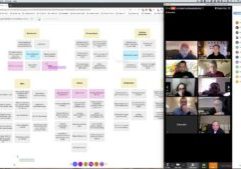Scanning many university website home pages, I still see this scenario all too frequently: The hero images and headlines at the top of the page show pictures from a recent event, or announce a speaker coming to campus, or last month’s alumni gathering.
There might be a rotation of images and stories, and they might even be related to a larger message. But it’s more likely that these stories are random rather than strategic. The rest of the home page is a battleground of competing factions, each believing their content is important to their audience and therefore must be available in this prime location. This also why so many home pages feature a smorgasbord of content modules — news close to the top, events on the right sidebar, social media down at the bottom, etc.
I can imagine how this happens — in fact this is how I've seen it go down many times:
This is what Faculty wants to see (That’s what we do here, even if Marketing forgets)
This is what Donors want to see (Their money is being spent responsibly)
This is what current students want to see (This helps build school spirit)
This is what the Administration wants to see (This usually quiets the room)
This is what Prospective Students want to see (Usually said by anyone involved in Marketing and/or Admissions)
These are all mostly true (except for the last one), and mostly irrelevant. Prospective students don’t want to see news, or events, or speakers. They could not care less — at least that’s what every single one I’ve interviewed has told me.
I’m sure these universities believe they are executing on their brand promise — they are showing the brand by displaying these news and events features on the home page, believing that prospective students will intuit what the university stands for through them. The thinking goes like this: Having the former president of Finland give a speech at your university shows how global you are. Showing pictures from the last alumni awards banquet shows how much fun you’ll have as a member of the tribe. Showing commencement pictures from 50 years ago shows how much you value tradition.
In my experience this is approach is too convoluted.
For one thing, it doesn’t take into account that most prospective students will visit your home page maybe 3–4 times, and then maybe never again, even if they enroll. That’s not enough exposure to your piece on next month’s speaker to impart anything about what the university stands for, or who the university is perfect for. Your prospective students need to know what your school looks like, what the experience feels like, and if they can they see themselves there, right now. The president of Finland isn’t going to communicate that.
Transitioning from Serving All to Serving Very Few
Prospective students don’t care about your news stories, or campus events. They do care about admission deadlines and degree programs. Accept that many of your imagined users don’t use the home page they way you think they do.
Review your analytics — your news, events, social buttons, giving…they aren’t getting attention. That’s because users have figured out a better source for this information, and are going there. Once you start meticulously going through every content block you’ve promised to some audience, you’ll discover that the audience has…disappeared. The clicks aren’t happening. The audience for the piece of content has wandered off to the place they found that has just the thing they’re looking for, without the 12 things they don’t need. You know who needs that space they’ve vacated? Prospective students.
The Big Idea
What do prospective students want to see? Well if I trust my research (and I do), or similar research conducted by others in the higher ed space, they want to see how much it will cost to attend your university. They want to see what your degree programs are like. They want to see what other students look like, and they want to see where they’ll stay up all night studying. And they’ll say that they’re not really interested in learning about your brand. So, what is that big space on your home page for?
That space is for telling stories.
Stories that resonate with prospective students.These stories should inspire, reveal, and explore deeper truths about the genuine experience that students become immersed in at your university. They should also be deliberate about your brand attributes. Headlines should feature brand-aligned keywords. Story subjects should demonstrate brand values. Students will say they can see through the hype, that they’re savvy interpreters of brand persuasion (and they are!), and that they’re too smart to fall for your “brand.” But here’s thing — do it anyway.
These students that are too smart to fall for your brand pitch have already fallen for a whole bunch of pitches. They’re buying clothes from a brand they accept (and not the other brand — wouldn’t be caught dead in it), using the right smartphone, the right chat app. They discover brands on Instagram, and join the tribe of believers, until the tribe moves on to something else. But make no mistake — they came to their beliefs about the brands they follow somehow, and those brands worked hard to achieve that.
They did it by telling stories.










